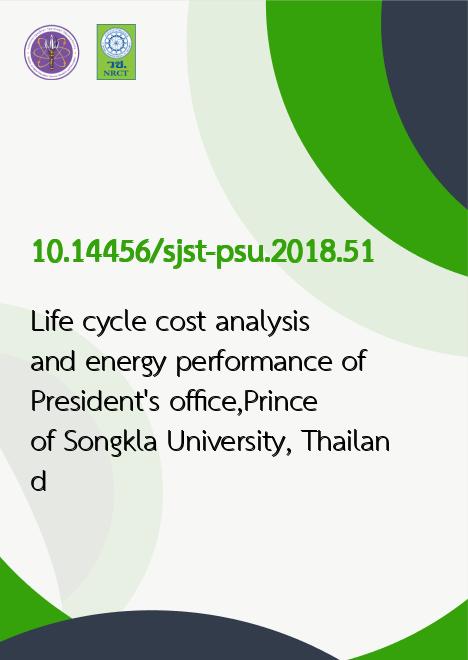
|
Life cycle cost analysis and energy performance of President's office,Prince of Songkla University, Thailand |
|---|---|
| รหัสดีโอไอ | |
| Creator | 1. Samnang Tim 2. Warangkana Jutidamrongphan |
| Title | Life cycle cost analysis and energy performance of President's office,Prince of Songkla University, Thailand |
| Publisher | Research and Development Office, Prince of Songkla University |
| Publication Year | 2561 |
| Journal Title | Songklanakarin Journal of Science and Technology |
| Journal Vol. | 40 |
| Journal No. | 2 |
| Page no. | 439 |
| Keyword | administrative building, energy efficiency, energy performance, life cycle cost, operational energy |
| URL Website | http://rdo.psu.ac.th/sjstweb/index.php |
| ISSN | 0125-3395 |
| Abstract | The importance of life cycle cost analysis for administration is to investigate the components and activities which areoutstanding engagements making high operational cost. This involves energy efficiency and consumption reduction fromoccupants in building. The aim of this study is to evaluate the cost of operational performance in administrative buildings ofPrince of Songkla University (PSU), Hatyai campus called President's office (PO). It has a 6,988 m2functional area includingexecutive, administrative, and meeting operations. The highest cost of operation comes from electricity consumption estimated tobe about 2,439,047 THB or 69,687 USD. To obtain the approximate energy performance of PO, energy audit was investigated.The primary operational energy was considered in four components;(1) Air-conditioning (AC) to cool the rooms, (2) Lighting toilluminate the rooms, (3) IT devices to process documents and database, and (4) auxiliary appliances to support administration. Inparticularly, AC system consumes the highest energy. Approximately 75% of the energy consumed in the building is attributed toadministrative operations. This study also suggests some solutions that have been recorded to be effective in reducing the energyconsumption of administrative building. The energy measures were divided into two different categories, reaching by internaland external factors. The most mutual recommendations were identified as lighting and air conditioning retrofits. Renewableenergy is an environmental friendly solution but installation has been proved to cost higher than saving cost. Furthermore, thereis still potential for improving energy performance not only by its physical characteristics but also by several significant factorssuch as occupant's behavioral change, and control of indoor environmental condition. The energy efficiency improvementrequires holistic measures for sustainable energy building. |
